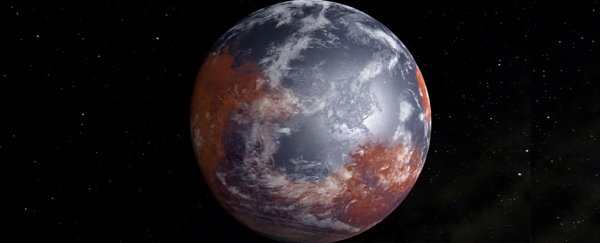Elon Musk wants to do it. NASA wants to do it. Heck, Arnold Schwarzenegger did do it (well, in a movie). But can it be done?
We're talking about terraforming Mars: turning the Red Planet back into a blue one, by geoengineering the hostile Martian environment into something hospitable to humans.
But according to new research, this sci-fi dream – one that is now shared by scientists – remains sadly, impossibly out of reach. For now at least.
The terraforming hypothesis encompasses a number of different strategies, but a common theme suggests that if enough carbon dioxide gas could be freed from under the Martian surface, the Red Planet's thickened atmosphere might one day shelter and support terrestrial life.
It's an awesome, inspirational plan – a dream that takes everything humanity has learned the hard way about planetary-scale global warming, and tries to apply it outwardly, in a positive direction that could one day save the very life of our species.
But sadly, according to new NASA-sponsored research, it's still just sci-fi.
"Our results suggest that there is not enough CO2 remaining on Mars to provide significant greenhouse warming were the gas to be put into the atmosphere," explains planetary scientist Bruce Jakosky from the University of Colorado, Boulder.
"In addition, most of the CO2 gas is not accessible and could not be readily mobilised. As a result, terraforming Mars is not possible using present-day technology."
Scientists have run the numbers on the prospects of terraforming Mars before now, but Jakosky and fellow researcher Christopher Edwards of Northern Arizona University had the benefit of years of new observational data from orbital NASA spacecraft such as the Mars Reconnaissance Orbiter, Mars Odyssey, and MAVEN (Mars Atmosphere and Volatile Evolution).
The thinness of Mars' almost non-existent atmosphere now – and the resultant lack of atmospheric pressure – means any liquid water on the surface would evaporate or freeze.
If we were somehow able to vaporise the carbon stored in Mars' polar ice caps – kind of like what Arnie does in Total Recall – the researchers say it would double the atmospheric pressure of the Red Planet.
But unlike what happens in the movie, this doubling would still only give Mars an atmospheric pressure equivalent to 1.2 percent of Earth's.
"It's not that terraforming itself isn't possible, it's just that it's not as easy as some people are currently saying," Jakosky explained to New Scientist.
"We can't just explode a few nukes over the ice caps."
There are other sources of carbon trapped on Mars though, in soil and mineral deposits, but again – per the team's calculations – there's just not enough natural resources there to turn the atmosphere into a temperate, humid greenhouse.
One final possibility is the potential for greater reserves of carbon to be buried deep inside the planet's crust – but at present we don't know enough about whether such an abundance exists, or where, and even if we did, we've currently got no reliable means of getting to it.
"We know there is some," Jakosky told Cosmos.
"It's exposed in a couple of impact craters. But we have no way of quantifying how much. More to the point, if it's buried deeply, it's essentially inaccessible."
Which doesn't mean there's no hope – it's just not something we can realise today.
The researchers say that in the years to come, perhaps decades from now, technological evolutions – in the hands of a fledging colonial operation on Mars – could enable us to pull off the terraforming plan.
One day. Maybe. We hope.
"We could still terraform Mars," Jakosky explained to Popular Science.
"We could manufacture high-efficiency greenhouse gases like chlorofluorocarbons and they would warm the planet, but that requires a more advanced manufacturing system that is far beyond our current capability. So if we do it, it's pretty far into the future."
So the dream, it seems, is still just a dream. But at least the dream isn't dead.
The findings are reported in Nature Astronomy.
